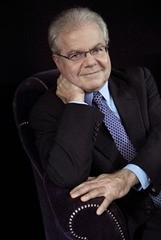|
Back
Odes to Joy New York
David Geffen Auditorium, Lincoln Center
01/05/2017 - & January 6, 7, 2017
Kurt Weill: Little Threepenny Music for Wind Orchestra
HK Gruber: Piano Concerto (World Premiere)
Franz Schubert: Symphony No. 2 in B Flat Major, D. 125
Emanuel Ax (Pianist)
New York Philharmonic Orchestra, Alan Gilbert (Conductor)

E. Ax (© Lisa Marie Mazzucco)
While virtually every New Yorker faces 2017 with a maximum of Fear and Trembling, Alan Gilbert broke the mold last night. The trio of works from three centuries played by the Philharmonic had been composed with delight, freshness and optimism.
Obviously any program with Emanuel Ax on the keyboard foretells happiness, even in this most unusual world premiere by HK Gruber. One might have questions about the worth of Mr. Gruber’s Piano Concerto, but Mr. Ax never let those questions interfere with his most eclectic performance. His was playing which, in 20 minutes, faultlessly essayed the range of long lyrical lines, jolly fireworks, a quasi-fugue or two and eccentric duets with Mr. Gruber’s large orchestra.

HK Gruber (© Boosey.com)
Which was both a blessing and a curse. HK Gruber, a showman, singer, double-bass player and the stellar opposite from most of Austria’s abstruse post-dodecaphonic composers, is an entertainer above all. And this Piano Concerto, taken from a scene of cabaret and Grand Guignol in his latest opera, is a very complex entertainment.
Not that we could not take this piece seriously. Mr. Gruber knows his orchestra well. Whether squeaks and squawks, whether clever doodling and tootling, whether vicious playing against Mr. Ax, or joining in with him and then leaving his playing for an entirely different style, Mr. Gruber knew what he was doing. Tri-tonality, tri-rhythms were nothing for this alchemist.
And thus the problem. From the start of the Piano Concerto–Mr. Ax with some meditative quiet chords, the woodwinds interrupting and shrieking–one didn’t quite know where one was going. No, we aren’t speaking of dark atonal tunnels, we are speaking of torrid climes, mountain peaks, lovely valleys, crowded town-squares, amalgamations and surprises.
So after a long five minutes with changes every few seconds, this listener gave up trying to decipher what was what, and simply attempted to enjoy the musical scenery.
Not an easy task, and not always satisfying, since Mr. Gruber’s mind wanders in Technicolor outtakes, barely cohesive only by Mr. Ax’s performance. Besides his wondrous work, he is a daring innovator. And I have little doubt he enjoyed this challenge as much as Mr. Gruber enjoyed the composition. So if we were lost in the confusion…well, that was our problem, not theirs.
A century before Mr. Gruber, Bertolt Brecht and Kurt Weill composed an update to the 18th Century Beggar’s Opera. And Weill’s own arrangement from the score for wind, percussion (timpani on one side, snare drum and cymbals on the other), banjo and bandoneon-accordion, caught as much of the flavor as Lotte Lenya and the original orchestra.
I have a feeling that Arnold Schoenberg, Weill’s teacher, would have been entranced with this Weimar Republic cabaret-style music. After all Schoenberg had written his own cabaret music–and Weill’s oh so clever modulations and interweaving counterpoint was absolutely delicious.
The songs were recognized, of course. But the sound, produced by the Phil winds and Mr. Gilbert’s conducting, brought us to a Berlin era that was magical in itself and presaged future horrors.
The final work was also joyous. Schubert’s Second Symphony has three movements were are as fresh as the young composer himself, long before syphilis gave that tragic aura to his more “mature” music.
Did the first and last movement reflect Haydn and young Beethoven? Yes, but this was no problem. Mr. Gilbert inexplicably started the Largo at almost an andante pace, but he then lunged into a work where the strings glittered with Rossinian sharpness. The second movement variations were pleasant enough, and the third movement (called “Menuetto” in the program, though Schubert simply called it Allegro vivace) and finale were equally animating.
In fact, with certain limitations, all three works offered a feeling that, despite the political aberrations of reality, something may be right with our world.
Harry Rolnick
|